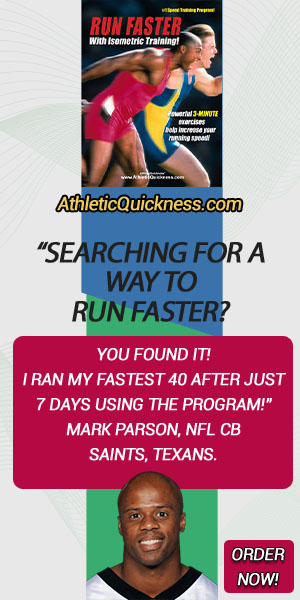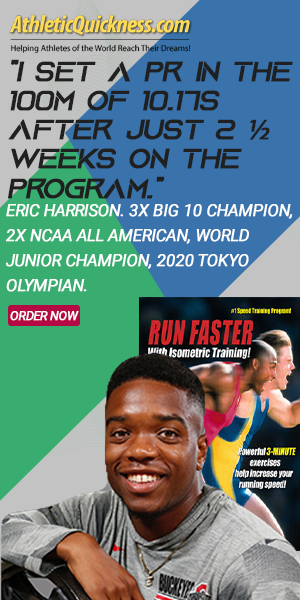“How To Improve Your Athletic Performance and Become a Better Player in Days; Not Weeks or Months – by Making Your Muscles Faster!”
Having fast muscles is not the same as having strong muscles and you can not get faster contracting muscles by training for strength using traditional weight training routines – in fact that could actually make you slower.
For speed, fast muscles will nearly always be more important than strong muscles – yet making your muscles faster is almost always misunderstood.
The reason muscles can be both strong and fast is because they are composed of basically two fiber types. One type (slow twitch fibers) for strength and endurance, the ability to move against heavy resistance and to perform repetitions without tiring. And another type of fiber (fast twitch fibers) for speed, quickness, and acceleration.
Muscle speed is accomplished by conditioning your muscles to perform what is called a ‘fast twitch response’ – which basically means to condition your fast twitch muscle fibers for their natural ability to contract with amazing speed and acceleration.
The bottom line is you cannot condition your muscles for speed using the same techniques you use to train for strength. You may think you are making your muscles faster with strength and endurance training routines but your muscles will always know the difference.
This is what most coaches, athletes and trainers have not grasped; and this is why athletes are often disappointed with their speed training results.
What we have discovered is that muscles are best conditioned for speed using a strategy of isometric exercises with resistance bands.
This is a training technique that by it’s very nature transfers speed qualities back into the muscles that are opposing them.
Isometrics using the resistance band, the way we teach it and the way we have shown you in the video, will unlock the blazing speed, acceleration and quickness of your fast twitch fibers.
The results will be dramatic increases in your athletic skills such as sprinting faster, kicking farther, jumping higher, or swinging a bat, tennis racket or golf club with more speed and power.
Increased speed will improve your athletic skills and help you become a better player – even if you are already a top performer. Your athletic career will be largely determined by how fast you are.
Once you start to exercise your muscles using this type of training, you will likely discover that up until now those muscles have been underdeveloped for speed.
And since developing your muscles for speed occurs much faster than training for strength or endurance you will start to see results in your sports performance in a matter of days – even if you are already in mid season.
The second key to improving your athletic performance is knowing precisely which muscles to condition.
Let’s use the hip flexor muscle as an example (also known as the thigh flexors). It is the primary muscle group responsible for speed in sprinting. Proper conditioning of the thigh flexor muscle will increase your running speed like never before.
Collectively as a group, the thigh flexors are among the strongest muscle groups in the body – yet they are largely ignored in most training programs.
Ironically, in spite of their importance, if you are like most athletes then your thigh flexors are also greatly underdeveloped for their full potential for speed.

Thigh flexors or hip flexors.
Main function is to raise your thigh and swing it forward.
This is the primary muscle group for faster sprinting speed.
The reality is that a lot of athletes, trainers and coaches are simply unaware of the importance of the thigh flexor muscles.
There can be many reasons why. Maybe it’s because at the gym there is typically not any single weight machine that can effectively condition these muscles and therefore they go unnoticed.
Maybe it’s because you really can’t see them since they are located deep in the anterior hip region further adding to their obscurity. Or perhaps people do not understand their importance or that they think they are training them when they really aren’t. But for whatever reason the thigh flexors are largely ignored.
With weak thigh flexors, your running speed will be significantly affected more than you could ever imagine. This is easily understood by defining their role in the running process.
The normal running process has three primary phases:
1 & 2) a Push and a Return phase when the foot is on the ground and
3) a swing phase when the leg and foot are moving forward.
It is during the acceleration portion of the swing phase where most of your running speed and power are generated. The “acceleration portion of the swing phase” is characterized by the flexing of the thigh upon the pelvis.
This is the main function of your thigh flexors.
The faster you can accelerate your thighs forward and upwards into this flexed position, the faster you will be able to run – it’s as simple as that!
The only way that I have ever been able to effectively isolate the thigh flexors is with resistance bands. No other method is more effective.
The only way I have ever been able to increase the speed of these muscles is with isometric training. Again, No other method is more effective at making these muscles faster.
This training strategy can be applied to any muscle group involved in an athletic skill. And often muscles that are often overlooked for training are crucial to the performance of that skill.
One key to getting speed in any athletic skill, swinging a bat or golf club, or kicking a soccer ball for example, is to train your muscles in the same plane as when the skill is performed. Isometrics with the resistance band is ideally suited to accomplish this.
The combination of using the resistance band with an isometric training strategy on the core muscles of any athletic skill, the way we teach it, is the secret to quickly improving performance in any sport- including football, baseball, soccer, basketball, tennis, golf, volleyball and lacrosse.
These exercise can be done basically anywhere. You don’t need to go to the gym to do it. You can do these exercises in the privacy of your own home in just a few minutes (like 15 minutes or less) a day. And they are appropriate for any age, fitness level or experience level.
We will show you precisely which muscles to develop and exactly how to develop them for speed.
Unless you have applied isometric training to your muscles using the resistance band, the way we teach it, you have a huge reservoir of untapped muscular energy just waiting to be released – even if you are already a top performer!
And always remember – being fast is not the same as being strong. You will need fast muscles to dramatically improve your athletic performance and become a better player.
Your friends, coaches and teammates will be amazed – and you will leave the competition in the dust!
By doing the exercises the way we show you, you can’t help but improve your sports performance and stand out from the crowd.



